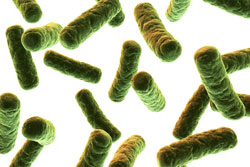- Introduction to food poisoning
- Impact of food poisoning
- What causes food poisoning?
- Which micro-organisms cause food poisoning?
- Foods which may house bacteria
- Signs and symptoms of food poisoning
- Who is most at risk?
- Long-term health risks associated with food poisoning
- Reporting cases of food poisoning
- Bacterial growth
- Preventing food poisoning through safe food preparation
Introduction to food poisoning
 Food-borne diseases are diseases that are transmitted by food. Food that has been contaminated with pathogens – including micro-organisms like bacteria or toxic substances like lead or mercury – can cause infection and/or toxicity if a person eats the food. Eating contaminated food causes the micro-organisms or other contaminants to enter your body.
Food-borne diseases are diseases that are transmitted by food. Food that has been contaminated with pathogens – including micro-organisms like bacteria or toxic substances like lead or mercury – can cause infection and/or toxicity if a person eats the food. Eating contaminated food causes the micro-organisms or other contaminants to enter your body.Water may also contain disease-causing micro-organisms or toxic substances (sometimes the same micro-organisms as contaminated food), which can enter your body and make you ill if you drink the water. These are known as water-borne diseases. Contaminated water may also cause water-borne disease if it is used for washing food, especially raw food like salad.
Food- and water-borne diseases are a considerable cause of illness. Around the world, an estimated 1.8 million people die each year from diarrhoeal diseases caused by food- or water-borne pathogens. Although most of these deaths occur in developing countries, food-borne illnesses are also a considerable cause of illness and death in developed countries.
Impact of food poisoning
Determining the exact number of food poisoning cases that occur each year is difficult because it is estimated that only 20% of people affected by food poisoning visit a doctor for treatment. Thus the vast majority of food poisoning cases go unreported. It is also difficult to definitively attribute the cause of food poisoning symptoms (e.g. vomiting, diarrhoea) to eating contaminated food.
Available evidence indicates that there are 5.4 million cases of food poisoning each year. Over 1.2 million visits to the doctor each year are because of food poisoning, and over 300,000 prescriptions are written each year for medicines to treat food poisoning. On average, 120 Australians die each year as a result of food poisoning, and 2.1 million days of work are lost because of food poisoning. The cost of food poisoning to the Australian economy is $1.25 billion each year.
Food poisoning is also a significant cause of morbidity and mortality in other developed countries. In England and Wales, an estimated 850,000 cases of food poisoning occur each year, and about 500 result in death. In the United States, approximately 5,000 food poisoning-related deaths occur each year.
What causes food poisoning?

Food often gets contaminated by bacteria from human hands. Contamination can occur during food processing, packaging, storage or preparation in the home or a restaurant. Bacteria may also be present in foods, especially raw meats, when they are purchased.
Food can also be contaminated if it comes into contact with or is produced from an animal that carries a disease-causing pathogen. Contact with contaminated water can also transfer disease-causing pathogens to food, such as when fruit is washed in contaminated water.
Soil can contaminate food when vegetables and fruit are not adequately washed prior to consumption. Soil and water may also contain heavy metals such as lead, murcury and cadmium, which can be transferred to food while it is growing (e.g. fish or vegetables).
Which micro-organisms cause food poisoning?
In Australia, food poisoning is most commonly caused by the bacteria Campylobacter (bacteria which infects the intestine) and Salmonella typhimurium (which causes salmonellosis).
Toxin-mediated food poisoning is mainly caused by Clostridium perfringens (bacteria commonly found in low concentrations in meat), Bacillus cereus (bacteria commonly found in soil) and Staphylococcus aureus (bacteria that inhabits skin, hair follicles and mucous membranes in humans). Listeria (the bacteria that causes listeriosis) and Escherichia coli (which commonly causes severe diarrhoea and gastrointestinal bleeding) infections are relatively rare causes of food poisoning but can be very serious. For example, they can cause intestinal bleeding and death.
Other toxins can occur naturally in food such as mycotoxins (toxins produced by tiny fungi) and toxins in fish such as ciguatera (caused by eating fish that have consumed toxin-producing algae). Other disease-causing agents that can contaminate food include prions (a type of protein) such as those that cause bovine spongiform encephalopathy (mad cow disease), persistent organic pollutants (POPs), and heavy metals such as mercury and lead.
Foods which may house bacteria

Some foods are particularly likely to house bacteria. They include:
- Unpasteurised milk and dairy products. Soft cheeses carry a particularly high risk;
- Raw or undercooked meat or poultry;
- Raw or undercooked eggs and foods that contain them, such as mayonnaise, salad dressings and cookie dough;
- Raw or undercooked shellfish;
- Improperly processed foods such as canned goods or salted meats;
- Unwashed fruits and vegetables.
Signs and symptoms of food poisoning
Symptoms of food poisoning vary depending on the type of infection, but may include:
- Diarrhoea (with or without blood in the faeces);
- Nausea and vomiting;
- Abdominal pain;
- Fever; and/or
- Headache.
The severity of symptoms varies depending on the individual’s health and the type of bacteria causing the infection. They may appear up to several days after the contaminated food was eaten.
People who are sick with suspected food poisoning should not handle food during preparation. Ideally, they should not be involved in food preparation for 48 hours following recovery, because during this time there is a risk that they can contaminate food and pass the infection on to someone else.
Medical attention should be sought if:
- Blood is seen in vomit or faeces;
- Diarrhoea persists after 2–3 days;
- A fever is present over 38.3oC;
- There is dehydration (indicated by thirst, light-headedness or dizziness) and fluids cannot be consumed due to vomiting or nausea; or
- The person with food poisoning is confused or has difficulty reasoning.
Urgent medical attention should be sought if:
- There is a lot of blood in faeces or vomit;
- Faeces appear black or maroon;
- The food poisoning is suspected to be from fish or mushrooms, or to be botulism (caused by Clostridium botulinum, a bacteria that most commonly infects improperly processed foods such as canned foods); or
- The heart rate is abnormal (e.g. beating too fast, too slowly, or irregularly).
Who is most at risk?

However, sometimes food-borne illness is more serious and requires medical treatment. Some people have a greater risk of becoming severely or fatally ill with food-borne illness. These people should always visit their doctor when they experience symptoms of food poisoning, including:
- Pregnant women;
- Young children and infants;
- Older people; and
- People who have diseases or take medicines that compromise their immune system, including those with cancer or AIDS.
Individual variation also occurs, so that some people may not get sick after eating a significant amount of bacteria, while others may develop severe illness after eating a very small amount of bacteria.
Long-term health risks associated with food poisoning
Food-borne illness can lead to a wide range of chronic diseases. These include:
- Arthritis;
- Cancer;
- Inflammatory bowel disease;
- Kidney failure;
- Guillain–Barré syndrome;
- Autoimmune disorders (a group of disorders which affect the immune system).
Reporting cases of food poisoning

Doctors and laboratories are required by law to report cases of certain diseases to health authorities. The information provided to health authorities helps to monitor disease and prevent outbreaks. For example, if several cases of food poisoning involving the same pathogen are reported in the same area, this might alert health authorities to the possibility of a source of contamination in that area (e.g. a restaurant or contaminated water source). The authorities can then investigate and take measures to prevent further contamination from the same source.
Some types of food poisoning are more dangerous than others, such as those where there is a high risk of severe illness or death. These cases must be urgently reported to health authorities, within 24 hours of diagnosis. There are slight variations between states, but generally the urgent cases of food-borne disease which must be reported within 24 hours include:
- Those involving:
- Botulism;
- Cholera;
- Hepatitis A virus;
- Listeria;
- Escherichia coli;
- Two or more related cases of food poisoning caused by any pathogen (e.g. cases in two individuals from the same area, who have eaten the same food); or
- Food poisoning in a food handler (e.g. a person who works in a kitchen or food processing area).
If you are sick with food poisoning, the doctor will notify the relevant health authority of your case. You do not have to do anything. The doctor may, however, tell you that information about your illness will be passed on to health authorities.
Bacterial growth
Food may contain very small quantities of harmful bacteria, although in small quantities many bacteria will not cause illness in a human. However, small quantities of bacteria can multiply rapidly when they are in warm environments that contain nutrients and water. Multiplication can result in enough bacteria growing in the food to cause illness in a human who consumes the food.
It is important to be aware that food contaminated with bacteria often appears normal. Bacteria do not produce a bad smell when they multiply, nor do they change the appearance of food. This makes it difficult to identify potentially contaminated food.
The exact time it takes bacteria to multiply depends on the species and environmental conditions. However, many bacteria begin to multiply rapidly after as little as two hours at room temperature. Refrigerating or freezing food can slow the multiplication of bacteria, but it does not destroy the bacteria – this can only be achieved by thorough cooking.
All bacteria multiply by dividing and replicating their cells, meaning that the number of bacteria in a particular environment (e.g. a piece of food) double within a given timeframe. The time it takes one particular bacterium to replicate is referred to as the generation time. If the generation time is 20 minutes, the number of bacteria contained in the food will double every 20 minutes. The more bacteria contained in the food, the more new bacteria will grow.
Preventing food poisoning through safe food preparation

Before handling food
- Wash your hands properly with soap for 15–20 seconds;
- Clean surfaces that come into contact with food thoroughly before and after processing each separate food item. Utensils such as knives, cutting boards and bench tops should also be cleaned before, during and after food preparation;
- Rinse all fruit and vegetables with running water before cooking or eating them;
- Do not rinse raw poultry and meat before cooking it. Rinsing raw meat under running water can cause the juices from the meat to splash and contaminate benches, utensils or other food.
Whilst handling food
- Don’t allow people who are sick with food poisoning to handle food. They may contaminate the food and pass their illness onto someone else. Ideally, someone who has had food poisoning should not handle food until 48 hours after symptoms subside;
- Use one cutting board for meat products, and a separate one for foods that can be eaten raw such as fruits and vegetables;
- Do not allow meat and meat juices to come into contact with food that can be eaten raw;
- Wash your hands thoroughly again if you have touched raw meat, been to the toilet, touched a pet or blown your nose;
- Wash all utensils between use on different food items. This is particularly important when a knife or cutting board is being used for meat or cheeses and raw food;
- If wearing disposable gloves, they should only be used for one task. When changing or commencing a new task, put on new gloves.
Cooking
- Bacteria that cause food poisoning can reproduce rapidly if they are left at room temperature for more than two hours. Make sure foods are refrigerated before cooking and as soon as possible afterwards;
- Keep raw meat separate from other food to prevent cross-contamination;
- If possible, use a meat thermometer to check the internal temperature of cooked meat. Once food is cooked, it should be kept below 5oC or above 60oC to prevent bacteria growing. Christmas meats such as turkey and ham should be cooked so that the internal temperature reaches 75oC;
- When properly cooked, the juices of turkey, chicken and mince should be clear and not cloudy or milky in appearance.
Reheating
Soups, marinades, gravies and sauces should be well cooked or boiled when reheating them;
- Food should be reheated to steaming hot (a mimimum of 60oC) as quickly as possible and within two hours of being taken from the refrigerator;
- Never reheat leftovers more than once. Take only the amount you intend to eat out of the refrigerator for reheating.
Serving food
- Do not leave food unrefrigerated on a serving table for long periods of time. Bacteria begin to multiply rapidly after two hours at room temperature. Ideally, cold food should not be left out of the refrigerator for more than an hour.
- Be wary at buffets, as it can be challenging to maintain proper food hygiene at a buffet. Potential issues include:
- Food being stored at the wrong temperature, either cold food becoming too hot or hot food becoming too cold;
- Food becoming contaminated because serving utensils are shared between dishes, or utensils are not used and food comes into contact with contaminated hands;
- Utensil handles might contaminate food if they drop into the dish. Handles have generally been touched by many people and may harbour many types of bacteria;
- Many people serve food from the same dishes and some may not practise good food hygiene. For example, they may eat from the serving dish or spoon, or they may use their hands to serve food;
- People standing in line to serve food may sneeze or cough, and this can contaminate the food.
Food storage
- Store raw meat in a rigid container that will prevent contact between it and other food. Store it at the bottom of the fridge to prevent cross-contamination from any drips that spill from the container;
- Food items that will not be cooked or reheated should never be defrosted at room temperature. Always defrost them in the fridge;
- Do not overfill your refrigerator. Cool air must be able to circulate to keep food cold;
- Eat all leftover cooked food within 48 hours;
- Check products for an expiry date. Foods with a ‘use by’ date should be frozen or disposed of on or before the use by date.
Utensils
- Keep cutting boards only if they are in good condition without scratches on their surface;
- Plastic and glass cutting boards are best for raw meat, although plastic boards should be replaced as soon as they become scratched;
- Scrub all utensils with hot water and detergent after they have been used on raw food, and before they are used again on cooked food.
General guidelines
- If you are in any doubt about whether the food is safe or not, throw it away;
- Be aware of how environmental conditions affect food, and throw away food that may have been contaminated because of exposure to environments that enable bacteria to grow, including:
- Cross-contamination, when a raw food has come into contact with a cooked food;
- Temperature, when food has been at room temperature for more than two hours or has been reheated on a previous occasion;
- Be prepared and organised:
- Ensure there is sufficient food preparation space to enable safe preparation, particularly the separate preparation of raw and cooked food;
- Ensure you have enough containers to store raw and cooked foods separately;
- Make sure you have enough room in the refrigerator to enable cold foods to be refrigerated.
More information
 |
For more information on nutrition, including information on types and composition of food, nutrition and people, conditions related to nutrition, and diets and recipes, as well as some useful videos and tools, see Nutrition. |
References
- Food safety and foodborne illness: Fact sheet no 237 [online]. Geneva: World Health Organization; March 2007 [cited 12 December 2010]. Available from: URL link
- Prevention of foodborne disease: Five keys to safer food [online]. Geneva: World Health Organization; 2006 [cited 9 December 2010]. Available from: URL link
- Monitoring the incidence and causes of diseases potentially transmitted by food in Australia: Annual report of the OzFoodNet Network, 2008 [online]. Canberra, ACT: Australian Government Department of Health and Ageing, Office of Health Protection; 2008 [cited 9 December 2010]. Available from: URL link
- Flint JA, Van Duynhoven YT, Angulo FJ, et al. Estimating the burden of acute gastroenteritis, foodborne disease, and pathogens commonly transmitted by food: An international review. Clin Infect Dis. 2005;41(5):698-704. [Abstract | Full text]
- Consumer fact sheet 2: Naturally occurring seafood toxins [online]. Brisbane, QLD: Queensland Government Department of Health; July 2010 [cited 12 December 2010]. Available from: URL link
- Food safety tips for healthy holidays [online]. Red Hill, ACT: Food Safety Information Council; 22 December 2009 [cited 12 December 2010]. Available from: URL link
- Food poisoning [online]. Silverwater, NSW: NSW Government Food Authority; 25 November 2010 [cited 19 December 2010]. Available from: URL link
- Food poisoning and cross-contamination [online]. Red Hill, ACT: Food Safety Information Council; October 2003 [cited 19 December 2010]. Available from: URL link
- Food safety at Christmas [online]. Red Hill, ACT: Food Safety Information Council; 2003 [cited 19 December 2010]. Available from: URL link
- Food safety standards: Thermometers and using them with potentially hazardous food [online]. Canberra, ACT: Food Standards Australia New Zealand; December 2010 [cited 19 December 2010]. Available from: URL link
- Zieve D, Eltz DR, Vorvick LJ, Longstreth GF. Food poisoning [online]. Bethesda, MD: MedlinePlus; 20 January 2010 [cited 3 January 2011]. Available from: URL link
- Procedure for notification of communicable diseases (excluding HIV/AIDS) [online]. Perth, WA: Government of Western Australia Department of Health; 2011 [cited 3 January 2011]. Available from: URL link
- Fact sheets for charities and community organisations: Preparing and cooking food [online]. Canberra, ACT: Food Standards Australia and New Zealand; 2010 [cited 3 January 2011]. Available from: URL link
- Food poisoning could dampen christmas spirit [online]. Red Hill, ACT: Food Safety Information Council; 21 December 2004 [cited 3 January 2011]. Available from: URL link
- Bacteria and foodborne illness [online]. Bethesda, MD: National Institute of Diabetes and Digestive and Kidney Diseases; May 2007 [cited 31 January 2011]. Available from: URL link
- Notifiable communicable diseases [online]. Perth, WA: Government of Western Australia Department of Health; February 2010 [cited 31 January 2011]. Available from: URL link
- Disease notification [online]. North Sydney, NSW: NSW Government Department of Health; 2011 [cited 31 January 2011]. Available from: URL link
- Food-borne illness [online]. North Sydney, NSW: NSW Government Department of Health; 2011 [cited 31 January 2011]. Available from: URL link
- Disease reporting guidelines for doctors [online]. North Sydney, NSW: NSW Government Department of Health; February 2006 [cited 31 January 2011]. Available from: URL link
- Notifying cases of infectious diseases within Victoria: How to notify [online]. Melbourne, VIC: Victorian Government Department of Health; 19 November 2010 [cited 31 January 2011]. Available from: URL link
- Notifying cases of infectious diseases within Victoria: What happens with the notification? [online]. Melbourne, VIC: Victorian Government Department of Health; 19 November 2010 [cited 31 January 2011]. Available from: URL link
- Quick guide for notifiable conditions in Victoria [online]. Melbourne, VIC: Victorian Government Department of Health; December 2009 [cited 31 January 2011]. Available from: URL link
- Notifiable conditions [online]. Brisbane, QLD: Queensland Government Department of Helath; 6 January 2011 [cited 1 February 2011]. Available from: URL link
- List of pathological, clinical and provisional diagnosis notifiable conditions: Public Health Regulation 2005: As at 30 October 2009 [online]. Brisbane, QLD: Queensland Government Department of Helath; 2 July 2010 [cited 1 February 2011]. Available from: URL link
- Notification of communicable disease [online]. Adelaide, SA: Government of South Australia Department of Health, Communicable Disease and Control Branch; 2010 [cited 1 February 2011]. Available from: URL link
- Diseases notifiable under Section 30 of the Public and Environmental Health Act 1987 [online]. Adelaide, SA: Government of South Australia Department of Health; November 2008 [cited 1 February 2011]. Available from: URL link
- Guidelines for notifiable diseases [online]. Hobart, TAS: Tasmania Department of Health and Human Services; February 2010 [cited 1 February 2011]. Available from: URL link
- Notifiable diseases for medical practitioners in the NT [online]. Darwin, NT: Northern Territory Government Department of Health; March 2006 [cited 1 February 2011]. Available from: URL link
- Report of notifiable disease or related death [online]. Weston Creek, ACT: ACT Government Department of Health, Communicable Disease Control; 22 June 2010 [cited 1 February 2011]. Available from: URL link
- Science in the real world: Microbes in action: Introduction to bacteria [online]. St Louis, MO: University of Missouri St Louis; 1999 [cited 21 February 2011]. Available from: URL link
- Healthy Christmas eating [online]. London: UK National Health Service; 2009 [cited 24 February 2011]. Available from: URL link
- Brown S. Food safety and buffet etiquette [online]. Brush Prairie, WA: Washington State University; 28 December 2005 [cited 3 February 2011]. Available from: URL link
- Fact sheets: Food labeling [online]. Washington, DC: US Department of Agriculture Food Safety and Inspection Service; 8 February 2007 [cited 3 February 2011]. Available from: URL link
- Keeping food safe: Summer eating: Food poisoning [online]. Silverwater, NSW: NSW Government Food Authority; 10 June 2008 [cited 22 February 2011]. Available from: URL link
- Clinical knowledge summaries: Food poisoning [online]. London: UK National Health Service; 2010 [cited 22 February 2011]. Available from: URL link
All content and media on the HealthEngine Blog is created and published online for informational purposes only. It is not intended to be a substitute for professional medical advice and should not be relied on as health or personal advice. Always seek the guidance of your doctor or other qualified health professional with any questions you may have regarding your health or a medical condition. Never disregard the advice of a medical professional, or delay in seeking it because of something you have read on this Website. If you think you may have a medical emergency, call your doctor, go to the nearest hospital emergency department, or call the emergency services immediately.

 Soups, marinades, gravies and sauces should be well cooked or boiled when reheating them;
Soups, marinades, gravies and sauces should be well cooked or boiled when reheating them;





